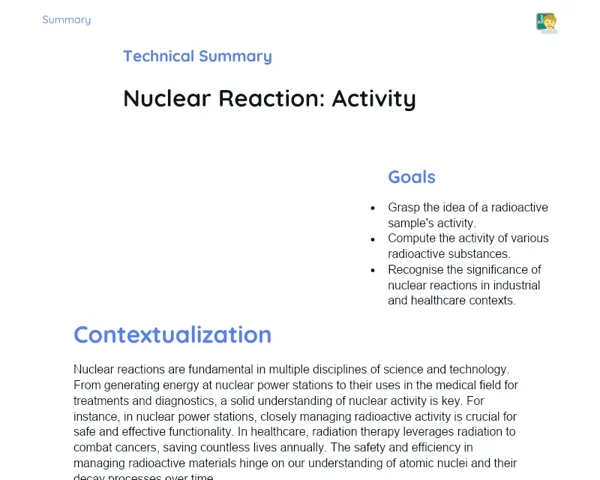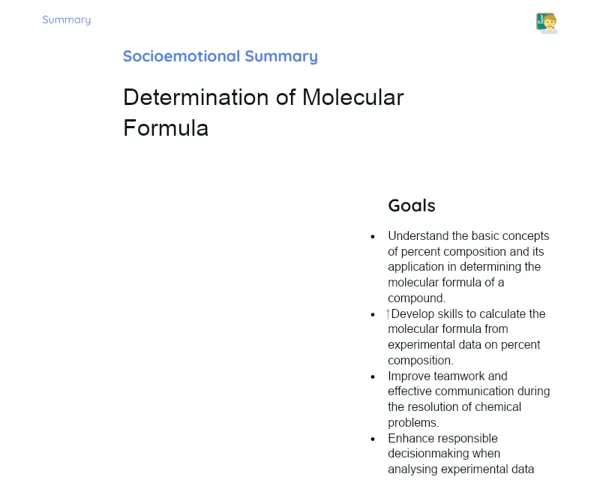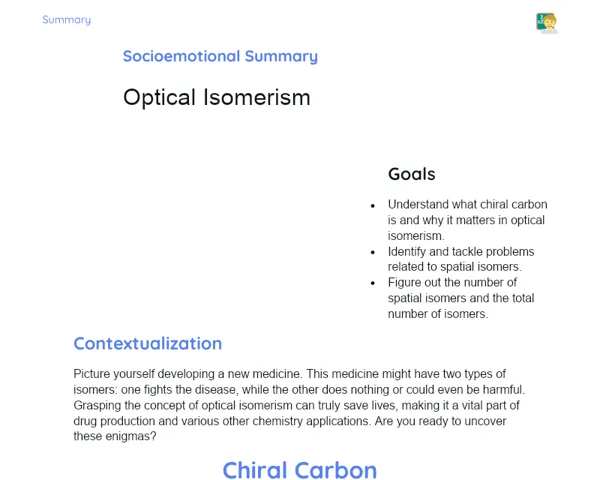Socioemotional Summary Conclusion
Goals
1. Grasp the concept of the mole and its significance in chemistry.
2. Learn how to calculate the amount of substance in moles and relate it to the number of atoms, ions, or molecules.
Contextualization
Have you ever considered how many atoms are packed into a tiny grain of salt? 🤔 The answer is likely to blow your mind! By harnessing the concept of the mole, we can quantify these minuscule particles and make the unseen visible! Let’s dive into this journey together and unlock the wonders of massive numbers in chemistry! 🌟🔍
Exercising Your Knowledge
Mole
The mole is a crucial unit in the International System of Units (SI) that measures the amount of substance. One mole is defined as the quantity of any substance that contains the same number of elementary entities (atoms, molecules, ions, etc.) as there are in 12 grams of carbon-12. This astounding number is known as Avogadro's Number, which helps us make sense of chemical reactions at a microscopic level!
-
Definition: A mole is the amount of substance that holds exactly 6.022 x 10³² elementary entities.
-
Chemical Context: In chemistry, the mole is essential for quantifying substances and performing stoichiometric calculations.
-
Visualization: Think of a mole as a 'magic box' holding 6.022 x 10³² particles, whether atoms, molecules, or ions.
Avogadro's Number
Avogadro's Number (6.022 x 10³²) indicates the number of particles in one mole of any substance. This number is a fundamental constant in chemistry that allows us to link the atomic/molecular scale with the macroscopic scale that we can observe and manipulate.
-
Universal Constant: Avogadro's Number is a constant that allows us to explain and calculate with macroscopic quantities of substances.
-
Conversions: We use Avogadro's Number to switch between moles and the number of particles.
-
Importance: This number lets us work with quantities we can see and measure, like grams and liters, based on incredibly small amounts, like atoms and molecules.
Molar Mass
Molar mass refers to the mass of one mole of a substance and is expressed in grams per mole (g/mol). It is essential for linking the mass of a substance (something tangible) to the number of moles (which gives insight into how many particles are present).
-
Definition: Molar mass is the mass of one mole of a substance, expressed in g/mol.
-
Calculation: It can be determined by adding together the atomic masses of the elements that constitute the substance.
-
Application: We apply molar mass to convert between the mass of the substance and the quantity of substance in moles.
Key Terms
-
Mole: The unit measuring the amount of substance in the International System of Units (SI), equivalent to 6.022 x 10³² elementary entities.
-
Avogadro's Number: The constant representing the number of particles in one mole, approximately 6.022 x 10³².
-
Molar Mass: The mass of one mole of a substance, presented in grams per mole (g/mol).
For Reflection
-
How can grasping the concept of the mole assist you in solving everyday problems, like figuring out medication dosages or mixing ingredients in a recipe?
-
Can you share a time when you encountered emotional challenges while tackling math or scientific issues? How did you navigate those feelings, and what might you approach differently next time?
-
In what ways can mastering calculations related to moles and understanding molar mass enhance your critical thinking and problem-solving abilities?
Important Conclusions
-
The mole serves as a vital unit in chemistry, enabling precise measurement of substances at atomic and molecular levels.
-
Avogadro's Number informs us about the number of particles in a mole, being a crucial constant.
-
Molar mass bridges the gap between the mass of substances and the number of moles, assisting in calculations and real-world applications.
-
Learning to compute the amount of matter in moles nurtures critical thinking and problem-solving techniques.
Impacts on Society
The notion of the mole directly influences daily life, particularly in medication dosages. For instance, pharmacists depend on the mole to ensure each tablet contains the right amount of active ingredient, providing patients with safe and effective treatment. Another crucial area is within the food industry. With a solid grasp of the mole concept, food scientists meticulously measure ingredients, ensuring recipes are safe and consistent—ranging from processed food production to developing nutritional guidelines suited to specific diets, enhancing health and well-being.
Dealing with Emotions
To manage your emotions while grappling with the mole topic, employ the RULER method. First, acknowledge your feelings during study time—are you confused, frustrated, or perhaps excited? Next, aim to understand the root of these emotions, whether it’s the complexity of an issue or the joy of solving it. Clearly label each emotion: anxiety, relief, elation. Share your feelings appropriately, whether through discussions with peers or writing down your experiences. Lastly, regulate those emotions. If stress arises, give yourself breaks for deep breathing. Should motivation strike, focus and celebrate your milestones!
Study Tips
-
Craft mind maps to visualise the connections between the mole, Avogadro's Number, and molar mass. 🔍🤯
-
Regularly practise calculating moles to bolster your understanding and capabilities. 📖🤓
-
Form study groups with classmates to collaborate and problem-solve together, sharing both knowledge and emotions. 🤝🎉



